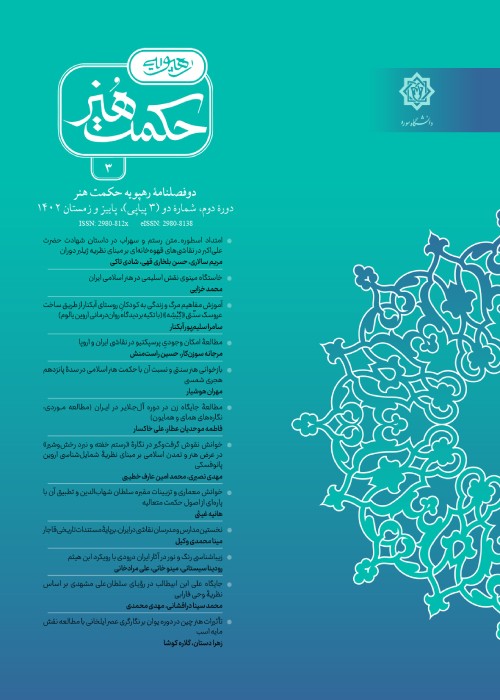Reading the Architectural Decorations of Sultan Shahabuddin’s Tomb and Comparing It With Some Principles of Transcendental Wisdom
The tomb of Sultan Shahabuddin or Sheikh Shahabuddin, located in Haji Delai, Larijan, Mazandaran, is one of the magnificent works of art that were created during the Safavid era. The issue is the close and deep connection between divine wisdom in general and transcendental wisdom in particular with Islamic and Iranian art and architecture. It is possible to compare works of art and ruling principles and to explain the manifestation of wisdom, especially transcendental wisdom, in works of art and architecture. The sublime wisdom founded by Hakim Sadr al-Muta’allihin Shirazi (Mulla Sadra) is based on several fundamental principles, including the principality of existence, gradation in existence, unity of existence, and substantial movement. This study seeks to match the aspects of Islamic Iranian architecture in the tomb of Sultan Shahabuddin with some principles of transcendental wisdom. The most effective approach to understanding the architecture and art of tiling and decorations from different periods is to comprehend each era’s key elements and prevailing principles. The words of sublime wisdom have the most accurate description of this art. Therefore, the question posed in this research is how to examine the principles of transcendental wisdom and the architectural concepts and decoration of the tile patterns of this building, either in calligraphy or in visual form. He made a connection between those principles and these concepts. Therefore, to answer this question, the present research aims to know the principles of Mulla Sadra’s transcendental wisdom and their relationship with the artistic and architectural aspects of Sultan Shahabuddin’s tomb. The ambiance of this structure is straightforward yet challenging to fully grasp. The building of this mausoleum looks like a simple building from the outside, but it is full of semantic complications from the inside. The most significant necessity of conducting this research is to pay attention to preserving the national capital. This building is now strangely empty of decorations and tiles. Some of its tiles, recovered from looters, were transferred to the Amol Art Museum, while profiteers looted many others over time. The method of the upcoming article is descriptive-comparative, and it seeks to achieve the goal of comparing some of the artistic features of the tomb of Sultan Shahabuddin Yehaji Dalai in Mazandaran with some of the principles of transcendental wisdom. The architect, tiler, and calligrapher of Sultan Shahabuddin’s mausoleum, with a symbolic and mysterious language, tries to induce the truth of existence by using the arrangement of light; principality of existence by creating spatial continuity in the building; gradation of existence with the hierarchies of spaces and plant motifs on the tiles, and even the verses and hadiths and mystical sayings on the six-layer tiles; the unity of existence with the pointed conical dome and the substantial movement with plant motifs. The results of this research, the materials of which were collected by field and library methods, show that the architecture and decorations of this building are in line with the principles of Sadra’s transcendental wisdom, especially the principality of existence, gradation of existence, and substantial movement.
- حق عضویت دریافتی صرف حمایت از نشریات عضو و نگهداری، تکمیل و توسعه مگیران میشود.
- پرداخت حق اشتراک و دانلود مقالات اجازه بازنشر آن در سایر رسانههای چاپی و دیجیتال را به کاربر نمیدهد.


